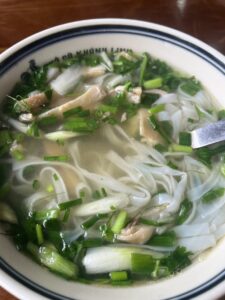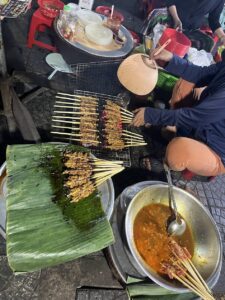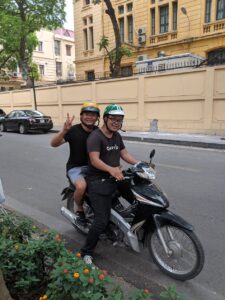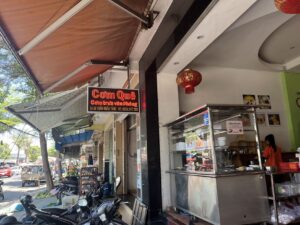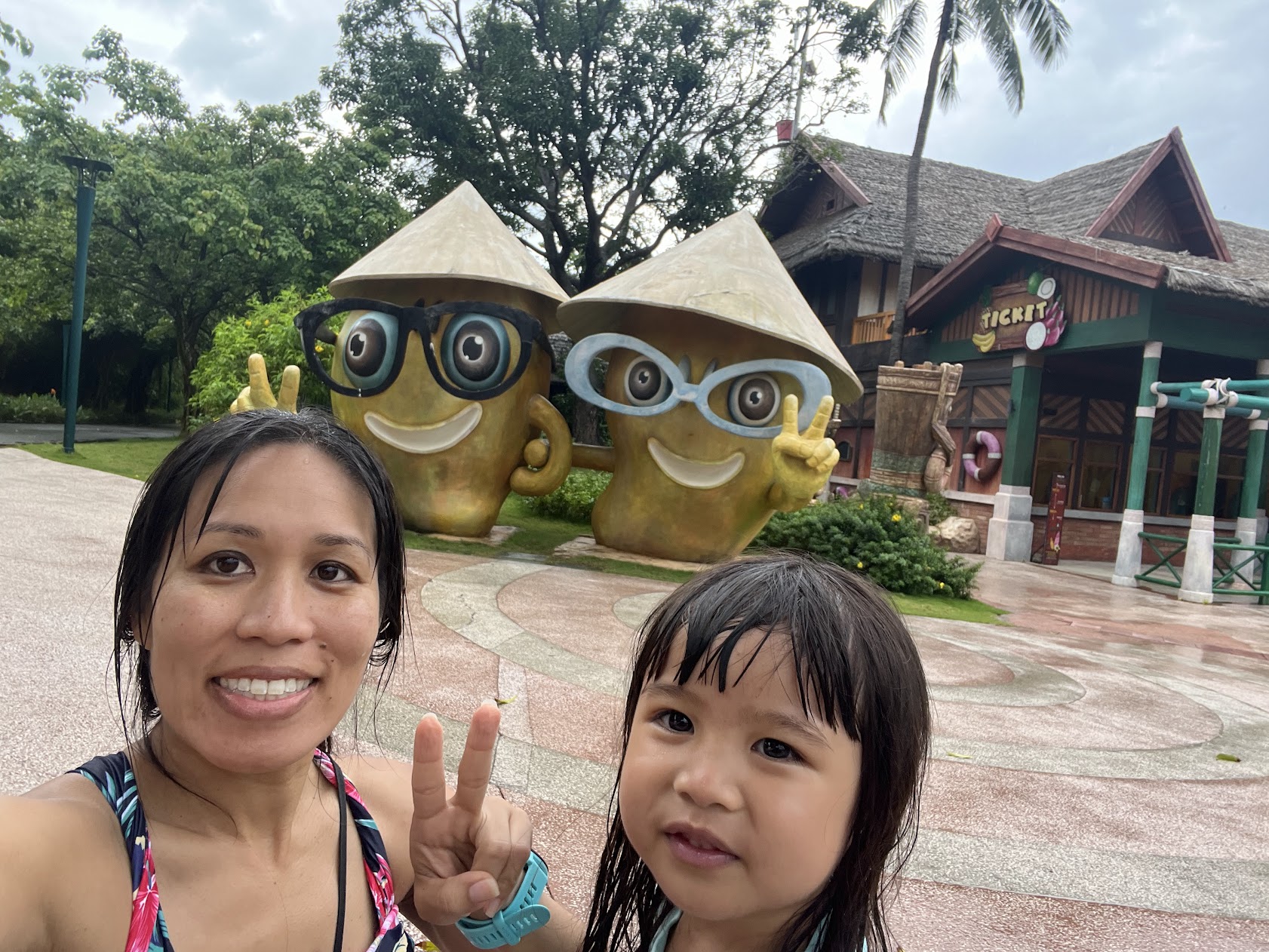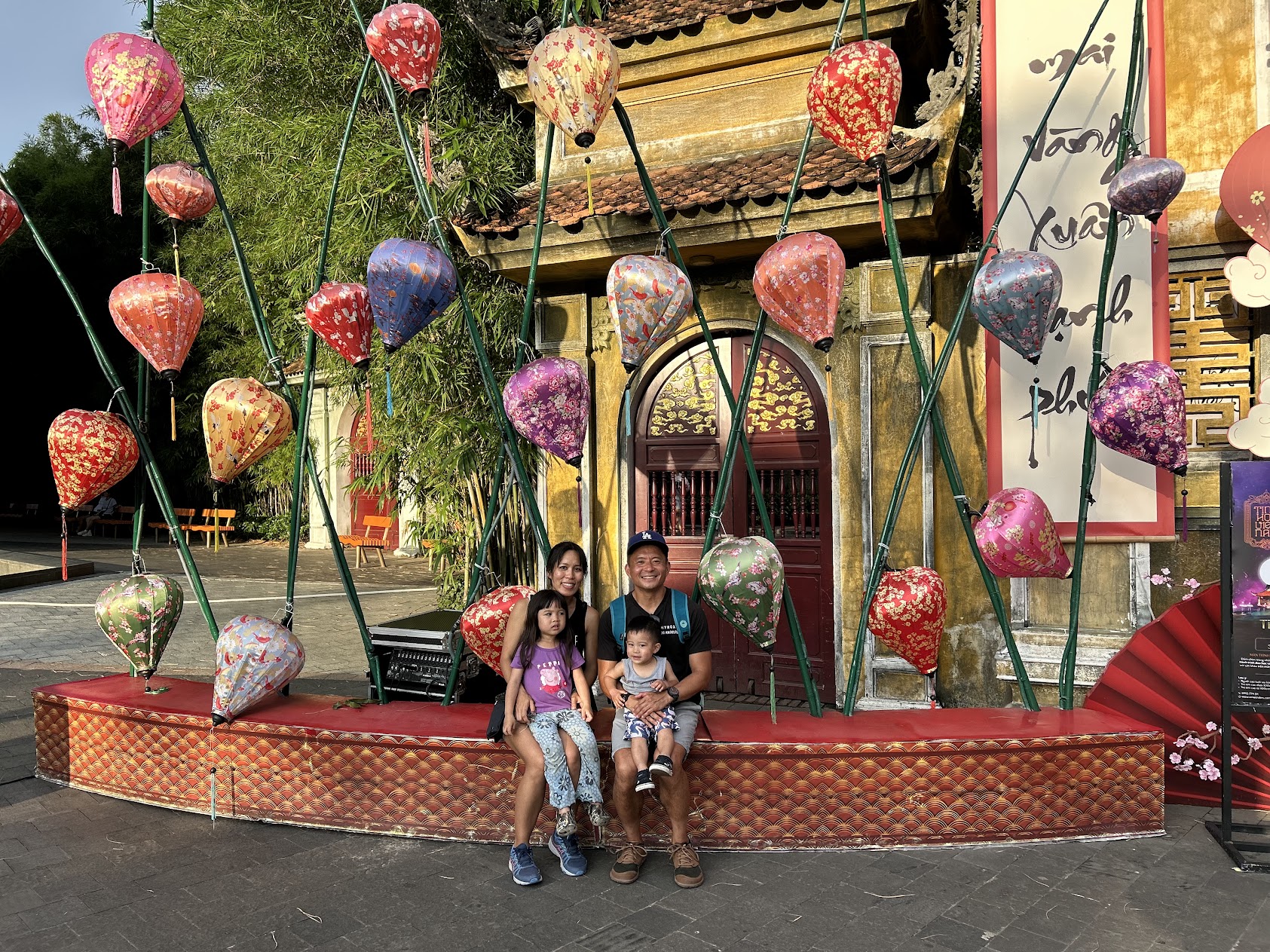
Vietnam Family Trip Tips: Unfiltered Advice After a Month with 2 Toddlers
When I first thought about bringing my two toddlers to Vietnam, I had a mix of excitement… and total panic.
I knew the country well. I had family here. I spoke the language. I even studied abroad—five months in Hanoi and three months in Ho Chi Minh City. But traveling with a 1.5-year-old and a 3.5-year-old? That was brand new territory.
We ended up spending a full month in Vietnam with our two toddlers—and while there were definitely a few meltdowns (those crazy toddlers, ya know?), it turned out to be one of our most rewarding and surprisingly doable adventures yet.
Vietnam is vibrant, budget-friendly, and incredibly welcoming to families. But it’s also full of the unexpected—sidewalks that disappear, street food that might test your gut, and a whole lot of attention for your little ones.
If you’re prepping for your first big Asia trip with kids, this guide has everything I wish I’d known ahead of time. From getting around and packing tips to food, safety, and what’s actually baby- or toddler-friendly—I’ve got you covered.
Our Favorite Tools for Traveling to Vietnam with Kids
These are the tools that made our Vietnam trip easier, safer, and way less stressful with toddlers in tow:
- 🌍 Travel Medical Insurance with SafetyWing – We use this international travel insurance to medical emergencies—especially with kids in tow.
- 🏨 Book your family stay on Booking.com – Find the best prices and filter for what parents actually need: free breakfast, pools, and close to the fun.
- 🌐 Get instant data with an Airalo eSIM – Set it up before you land and stay connected without airport Wi-Fi drama.
- 👜 Tobiq 30L Duffel Bag – My go-to diaper bag for flights and long travel days. Built-in color-coded pockets keep everything organized. (Includes a 15% off code!)
- 👶 Toddler Carrier – Navigating Vietnam’s narrow sidewalks and crowded spots? This ergonomic carrier kept our hands free and kids comfy.
- 🔌 Universal Adapter – Works in 150+ countries, fits 3-prong plugs, and has a push-button safety lock to keep little fingers out.
- 🧳 Passport Holder – Finally, something to organize our passports and boarding docs so I wasn’t fumbling at every checkpoint.
Is Vietnam Kid-Friendly?
Totally. Vietnamese culture is deeply family-oriented, and kids are genuinely welcomed just about everywhere. Strangers often smiled, waved, or even offered our toddlers snacks before saying hello—and not in a creepy way, just pure hospitality.
It also helps that Vietnam is incredibly budget-friendly. Hotels, meals, transportation—it all adds up to way less than you’d spend traveling with kids in the U.S. or Europe. On this trip, we were able to afford hotels that had amazing kids club play areas and water playgrounds—a luxury we just wouldn’t splurge on back home.
Was everything perfect? Of course not. But overall, it’s a warm, accessible, and surprisingly easy place to travel with little kids—especially if you’re flexible and go with the flow.
Vietnamese Food For Kids
What My Picky Eater Actually Ate (and Loved)
Traveling with a picky eater? I totally get it.
Serena is our cautious one when it comes to food, and I was worried she’d barely eat in Vietnam. But to my surprise, we found a few staples that became our default meals throughout the trip:
- Plain rice and grilled chicken (com ga nuong)
- Vermicelli noodles with grilled pork (bun thit nuong)
- Pho, both chicken and beef—especially comforting when she was a little tired or overwhelmed
- Nem pork skewers from night markets—meat on a stick = always a win
- Scrambled Eggs—simple and familiar
- Cha lua (Vietnamese pork sausage roll) often showed up at hotel breakfast buffets and paired easily with rice or bread
- Pizza—after too many consecutive Vietnamese meals, we would always throw in some pizza, which is my husband’s favorite and always a yes from my kids
These weren’t just “survivable” meals—she genuinely enjoyed them, which made eating out way less stressful. To add to this, she is a carb girl, so give her rice, noodles, bread, but she’ll push away the protein, so we always have to try a little extra to get her to eat it.
Deconstructing Food for Picky Kids
One of the biggest mealtime hacks we discovered in Vietnam was deconstructing dishes for our picky eater.
Take bánh mì, for example. On paper it’s perfect—carbs, protein, veggies—but Serena wasn’t into the pickled carrots, daikon, or lettuce. So instead of handing her the whole sandwich, we gave her the ingredients separately:
- 🥖 Crusty bread on its own (a win!)
- 🍗 Grilled pork or chicken on the side
- 🥕 Skipped the veggies (or Bryan and I ate them ourselves)
We did the same thing with vermicelli bowls. Instead of serving it mixed with noodles, meat, herbs, and toppings all at once, we’d:
- 🍜 Put the noodles in a small bowl
- 🍖 Add the protein separately
- 🌿 Skip or minimize the veggies (she seems to be cool with cucumbers but not other herbs)
Honestly, deconstructing food became our go-to. It kept mealtime less stressful and made sure Serena ate at least something from each dish.
What Our Adventurous Eater Tried (and Mostly Liked)
Huntington is the opposite—he’s our adventurous eater and wanted to try everything at least once. He surprised us by taking bites of:
- Banh can (small rice flour pancakes)
- Egg rolls (or crispy spring rolls)
- Fresh spring rolls
- Banh mi sandwiches (with veggies intact!)
- Any juice or smoothie we handed him
He didn’t always finish everything, but his willingness made meals way more flexible. If you’ve got a curious eater, Vietnam can feel like one big taste test.
Fresh Fruit and Juice Is a MUST in Vietnam
Vietnam is packed with tropical fruits and fresh juice stalls—and both kids were obsessed. Our favorite? Watermelon juice. It was everywhere, cheap, and incredibly refreshing after a sweaty morning walk.
We also tried mango, passionfruit, and lychee juices. Smoothie stands became our mid-day break spots, and I felt better knowing they were getting some vitamins on the trip.
It was such a relief to find something both kids happily drank without complaints.
Food Safety Tips for Families
Street Food: What We Do (and Don’t) Eat Now
I love Vietnamese street food. Some of my most memorable meals came from tiny stools on sidewalks…BUT I’ve also been that person throwing up in a restaurant bathroom from food poisoning, so now I’m more cautious—especially with kids in tow.
Here are my go-to rules:
- Grilled, boiled, or cooked-in-front-of-you food is your safest bet. Heat kills bacteria.
- Busy stalls are your friend—high turnover means fresh ingredients
- Wipe utensils with lime wedges or baby wipes—thanks to my dad for that lifelong habit
- Avoid raw vegetables at street vendors unless you know they were washed with clean water or can ask for them to be blanched
- Skip pre-cut fruit—you never know how long it’s been sitting out. Ask the vendor to slice it in front of you
- Ask if juices are freshly made—I always skip the syrupy versions. My line: “Only the best for my kids… and me!”
- Check the ice – Ice in Vietnam is mostly safe these days, especially if it’s the kind that’s cylindrical or hollow in the middle—that usually means it was made with purified water. If you see someone breaking ice off a large block, it’s best to skip it just to be safe.
These tips helped us enjoy street food safely and confidently, and we didn’t have a single food issue with the kids.
Always Drink Bottled or Filtered Water
This one’s non-negotiable: only drink bottled or filtered water. Most hotels offered filtered water, which we used to top off our reusable bottles each morning. Sometimes, they would give us a few complimentary water bottles too. Otherwise, we’d buy big water jugs at the market and pour from there.
We used tap water for brushing teeth and just spit it out—but if you’re traveling with a younger toddler who doesn’t know how to spit yet, use bottled or filtered water instead.
Eating At Restaurants With Little Kids
What to Expect with High Chairs (or Lack Thereof)
At larger, sit-down restaurants, we found high chairs to be common, but most of the mom-and-pop shops didn’t have any.
So what they did have? Those classic tiny plastic stools.
Honestly? They were perfect for our kids’ size and felt way less stressful than balancing in a high chair. They couldn’t fall off, climb out, or wiggle away. It worked! I’d argue that it’s safer for our little ones (if they’re not trying to run away).
Tipping Culture
Vietnam isn’t traditionally a tipping culture. However, tipping is becoming more accepted in tourist-heavy or higher-end settings:
- Not expected at street food stalls or local eateries.
- Appreciated at mid-range or upscale restaurants, especially if no service charge is included. Around 5–10% is kind and generous.
Where to Buy Baby & Toddler Essentials in Vietnam: Con Cung Is Your Best Friend
If you’re traveling around Vietnam with young kids and wondering where to buy baby items—Con Cung is your answer. You’ll know it when you see it: bright pink storefronts, stocked to the brim, and found all over the country in major cities and towns.
💭 Real Talk: I forgot my nursing cover at home (left it hanging on the bedroom door—classic mom move), and I was so relieved that Con Cung sold them.
What You Can Buy at Con Cung
- Diapers & Wipes: Available in bulk or smaller packs. You’ll find cheaper prices than at convenience stores or mini marts.
- Formula & Snacks: They stock powdered milk, toddler snacks, vitamins, and baby food—perfect for picky eaters or sensitive tummies.
- Baby Toiletries: Diaper cream, baby shampoo, lotion, and even mosquito patches.
- Clothing: From newborn onesies to toddler outfits—great in case of wardrobe malfunctions or unexpected weather changes.
- Gear: Some locations sell strollers, cribs, and baby-proofing items. (We even saw a travel-friendly potty seat!)
- Maternity & Nursing Items: Think nursing covers, breast pads, and postpartum care kits. That’s where I grabbed my emergency nursing cover.
Packing Tip for Longer Trips
Since we were in Vietnam for a month, we packed just enough diapers and wipes for the first few days. Then we stocked up at Con Cung and supermarkets along the way. It saved so much space in our luggage—and our sanity.
Other Places to Find Diapers, Wipes, and Formula
- Convenience stores (like Circle K, FamilyMart): Great for a quick pack of diapers or wipes in a pinch, but prices are higher and sizes are smaller.
- Supermarkets (like Coopmart, Lotte Mart, or GO! (formerly Big C)): Also carry diapers and wipes in larger packs, while stocking up on snacks and fruits at the same time.
How To Get Around Vietnam With Toddler and Little Kids
Getting around Vietnam with little ones can be… well, it can feel chaotic. But honestly? It’s totally manageable once you get the hang of it—and the stories make the best part of the adventure.
Rideshare Apps – Grab and Xanh SM
Instead of dealing with sketchy taxi meters that jump just because you’re a foreigner (I can’t even count the number of times this has happened to me), we stuck to rideshare apps:
- Grab – dependable and everywhere.
- Xanh SM – electric cars, sometimes cheaper, fewer drivers.
Pro-tip: Set up your credit card payment before landing—you don’t want to deal with your bank blocking an unexpected international charge in a hot city with upset toddlers.
Domestic Flights – Vietnam Airlines vs VietJet
We flew both Vietnam Airlines and VietJet multiple times during our trip, and here’s what I would recommend:
Vietnam Airlines – My Top Pick If Prices Are Close
- Checked bags included
- More legroom (even in economy!)
- Sometimes includes in-flight snacks and entertainment
- Overall, a more comfortable experience
Vietjet – Best For Budget Travelers
We used them when the total cost (plus baggage fees) was still much cheaper than Vietnam Airlines.
- Expect tight legroom—I’m 5’0″, and my knees almost touched the seat in front of me
- Smaller space for personal items
- No frills, but gets the job done and domestic flights tend to be short anyway
Flight Delays
Unfortunately, we experienced flight delays with both airlines—so build in a little buffer if you have tight connections.
Motorbikes – The Local Way to Get Around
Motorbikes are the main way locals travel in Vietnam.
If you’re planning multiple trips a day, renting one can save you time and money. No waiting for drivers or dealing with surge pricing—just hop on and go.
- Some of our parent friends raved about the freedom of having their own motorbike.
- But for us—a family of four with a 1.5- and 3.5-year-old—Grab cars were a better fit.
Even though I’d driven motorbikes in Vietnam years ago, neither Bryan nor I felt confident riding with toddlers on board. And on hot, sticky days? Air conditioning felt like a luxury we weren’t willing to give up. Plus, we were on vacation—we wanted less work, not more.
That said, Bryan sometimes took Grab motorbikes for quick solo trips (like after his morning runs). It’s super convenient when you’re alone.
🚨 Important note about helmets: Most Grab motorbikes only come with one adult helmet—not for kids. Helmet laws currently apply only to children 6 and older, which honestly feels a little backwards (no protection for our tiniest kids).
👉 Pro Tip: Planning to ride on a motorbike with kids? Buy your own helmets.
Car Seats in Vietnam
Car seats are basically nonexistent.
Most vehicles don’t have them, and seat belts? Sometimes they’re there… sometimes they’re hidden or tucked under the seats.
If car seats are essential for your peace of mind:
- Bring your own
- Hire a private driver who’s willing to install and keep it in while you’re exploring
We didn’t bring car seats on this trip and went with the “when in Rome…” approach. Honestly, cars drive a lot slower here, usually surrounded by motorbikes, which made things feel safer than we expected.
👀 Coming Soon:
Starting January 2026, Vietnam will require kids under 10 years old and under 135 cm to ride in a car seat in the back seat of a car.
Strollers vs Carriers
- Sidewalks aren’t super stroller-friendly — expect broken pavement, parked motorbikes, food stalls, and outdoor seating in your way.
- We used carriers for our 1.5- and 3.5-year-olds, which made navigating busy areas much easier.
- This was our personal preference—we’re used to wearing our kids for long stretches (though toddlers are in and out all day anyway).
- Strollers can still work, especially in calmer cities like Da Nang, Phan Rang, and Phu Quoc.
- In more crowded areas and busier cities, you’ll sometimes have to reroute the stroller into the street and back onto the sidewalk—motorbikes will usually weave around you.
What to Pack for a Vietnam Family Trip
When you’re traveling with toddlers, the right gear can make or break your day. We spent a month in Vietnam with our 1.5-year-old and 3.5-year-old—and here’s what you actually need.
Essentials for Vietnam’s Climate
- Lightweight, breathable clothes (shirts, shorts, dresses)
- Sun hats & sunscreen – It’s hot, humid, and sunny most days.
- Mosquito repellent – We used DEET-free options for the kids and were glad we packed it.
- Waterproof jacket – I always pack 1 per person just in case for the rain
Getting Around
- Carrier or stroller – We used carriers only the entire trip, which made it easier to navigate broken sidewalks and crowded streets. But a lightweight stroller could be handy in less busy areas or more developed areas and malls or with multiple little ones.
Staying Hydrated + Fed
- Reusable water bottles – Easy to refill at your hotel or with big water jugs from a convenience store.
- Snacks – Bring a few familiar ones for the flight, then stock up locally. Trying new snacks is half the fun of traveling!
Health & Safety
- Mini first-aid kit – Thermometer, fever meds, bug bite cream, etc.
- Any daily medications your child might need
- Toiletries & baby care – Basics like shampoo, conditioner, toothpaste, diapers and wipes are easy to find at supermarkets and convenience stores, but bring any must-have brands just in case.
Staying Organized
We used our Tobiq 30L bag as a diaper/day bag and loved the organized compartments:
- Toys
- Snacks
- Extra clothes + hats
- Diapers + wipes
- Water bottles fit in the side pockets, and the iPad had its own padded spot for restaurant entertainment.
I also use colorful packing cubes to separate each person’s clothes.
How To Pay In Vietnam
You’ll need a mix of credit cards and cash when traveling in Vietnam. While many hotels, restaurants, and shops accept cards, cash is still king at local eateries, food stalls, and markets.
Credit Cards
- Accepted at most hotels, malls, and sit-down restaurants
- Choose local currency if the card machine asks (choose VND, not USD) —this avoids hidden fees
- Use a card with no foreign transaction fees (we used Chase Sapphire Reserve to earn points — 3% cash back on restaurants and 4% on hotels works even abroad, so it’s my first choice to use credit card whenever I can for cash back or points)
Cash Tips
VND comes in large denominations like 1,000, 10,000, 100,000—and you won’t get much for anything under 1,000 VND, kind of like how you can’t get much in the U.S. for under a dollar.
We used our Charles Schwab bank card, which was perfect for travel:
- Reimburses all ATM fees
- No foreign transaction charges
- Lets you pull out smaller amounts at the real bank exchange rate
- I don’t have to worry about finding an ATM with a low fees or no fees
- I don’t have to worry about finding a money exchange place with a good exchange rate (but if you’re looking for 1, gold stores are the best)
We usually withdrew about $100-$200 at a time—which made us instant millionaires! At the time, the conversion rate was about 16,000 VND to $1 USD, so our ATM receipt showed well over 1.6 million VND. It takes a little mental adjustment to get used to the large numbers.
Is Tipping Expected in Vietnam?
Vietnam isn’t traditionally a tipping culture, but expectations have shifted in tourist-heavy areas. You won’t be expected to tip at mom-and-pop shops or street stalls, but in hotels, tour services, and nicer restaurants, tips are often appreciated—and sometimes subtly expected.
Example: Before a boat ride in Hoi An, our guide specifically mentioned tipping the rowers at the end.
💡 Tip when:
- You receive excellent service on a tour
- A guide or driver goes above and beyond
- You’re at a touristy restaurant or resort
Even a small tip (20,000–50,000 VND) goes a long way and is always appreciated.
How To Stay Connected in Vietnam
How to Get Mobile Data in Vietnam
Most hotels, coffee shops, and restaurants offer free Wi-Fi—but trust me, you’ll definitely want mobile data when you’re out and about, ordering a Grab back to the hotel, scanning a sign with Google Translate, send a WhatsApp message to your tour guide or driver, or searching for directions to your next destination. Also nice to pull up a video when you want your kid to just be quiet for a few minutes.
You’ve got two solid options for staying connected:
1. Get a Physical SIM or eSIM from a Local Phone Provider
Once you arrive, head to a Viettel or Vinaphone or Mobiphone store. They offer:
- Physical SIMs or eSIMs (Only phones from about 2018 or newer typically support eSIM)
- Affordable prepaid data plans
- Strong coverage—even in more remote areas
Bring your passport – It’s required to register your SIM card in Vietnam for security and identification.
Tip: Make sure your phone is unlocked, especially if you’re coming from the U.S., where phones are often carrier-locked.
2. Use Airalo – eSIM Through an App
We preferred Airalo and loved it for the convenience:
- Buy and install directly from your phone
- Set it up before your trip or once you land—just make sure you’re connected to Wi-Fi
- It activates automatically and connects to a local network—no stores, no hassle
- Perfect when you’re already juggling two toddlers and just want one less thing to worry about
Use Google Voice – Make Free Calls Back to the U.S.
Whether you’re trying to unblock a credit card, confirm a flight, or call family (I call it “adulting”), you might need to dial a U.S. number at some point.
💡 Use the Google Voice app:
- Link it to your U.S. number before you leave the country
- Use Wi-Fi or data to make free calls back to the U.S.
This was a lifesaver when I had to call Chase Bank after my credit card failed to link to the Grab app!
Stay in Touch with Friends & Family
Need to check in with loved ones back home? Here are easy ways to stay connected internationally:
- iMessage / FaceTime – if you’re both on iPhones
- Facebook Messenger – video, audio, and chat
- WhatsApp – video, audio, and chat
- Google Voice – for actual U.S. phone calls
Use Google Translate (Even If You Speak Vietnamese)
Even though I speak Vietnamese, my husband doesn’t—and there were definitely times when Google Translate saved the day.
- One time, Bryan was out for a run and needed a bathroom. He typed, “Where is the bathroom?” into Google Translate, showed it to a local, and got pointed in the right direction immediately (along with a chuckle).
- We also used it at street food stalls or small shops when things got confusing—just typing out a quick question and showing the screen made communication smoother.
Pro Tip: Use the camera scan feature.
- You can hover your phone over signs, menus, or packaged food labels and the app will translate the text on your screen.
- It’s not always perfect, but it’s good enough to avoid ordering something your kid might absolutely hate.
Honestly, we used Google Translate way more than we expected. It’s one of those tools that feels optional… until you really need it.
How To Enter Vietnam With Kids
Vietnam Visa Requirements for US Citizens
If you’re coming from the U.S., everyone in your family—including babies—needs a visa. You must apply in advance and have an approval letter in order to board the plane.
👉 Apply through the official government site: https://evisa.gov.vn/
⚠️ Beware of third-party sites that charge way more and show up on the first page of your Google search!
💰 Cost:
- $25 USD single entry (up to 90 days)
- $50 USD multiple entry (up to 90 days)
Processing Time: 3–7 business days, but I’d give yourself at least 2 weeks—especially around holidays like Lunar New Year when offices close for a week.
My Mistake (don’t repeat it!):
I applied too close to our flight and didn’t realize you need the visa approval letter before boarding. We ended up paying $255 per person for rush processing—over $1,000 total—just to get on the plane. Painful lesson learned.
Pro Tip: Always apply for the full 90 days. We applied for exact dates, but after my father-in-law passed away, we had to reapply. Having extra days built in would have saved us the stress and money.
Learn more about Vietnam visa requirements for US Citizens and all the mistakes our family made.
Vietnam Airport Rules For Families
- At the airport, you’ll need to remove your child from carriers during security. When we traveled solo, staff were really helpful when we asked. Most airports also have priority lines for families with kids under 2, which is a huge time-saver.
- Family priority lines: Most Vietnamese airports have a separate line for families with kids under 2—a total lifesaver when you’ve got antsy toddlers in tow, ready to run off without us.
- Carrier rules: Unlike U.S. airports, you’ll need to take your child out of the carrier during security screening. If you’re traveling alone, this can get tricky fast. One time, my husband and daughter had already crossed security when they made me take my sleeping 1.5-year-old out of the carrier. I suddenly had no hands to push our luggage through the security belt, but thankfully the security officer just stepped in and helped me.
Pro tip: If you’re traveling alone with kids, don’t hesitate to ask for assistance – the airport staff are generally very helpful with families!
FAQ: Vietnam with Kids
Is it safe to travel with kids in Vietnam?
Yes, I felt safe the entire time traveling with my toddlers. Vietnam is very family-oriented, and people genuinely love kids. Strangers often smiled, waved, and even offered snacks to my little ones before saying hello. Of course, there are the usual challenges—chaotic traffic, uneven sidewalks—but nothing that made me feel unsafe. We leaned on rideshare apps like Grab, avoided motorbikes with the kids, and stuck to busy, well-lit areas at night.
What are the best places to travel with kids in Vietnam?
It depends on your family’s vibe:
- Hanoi & Ho Chi Minh City – fun for short stays, cultural experiences, and great food.
- Hoi An – lantern-filled streets, boat rides, and lots of charm.
- Da Nang – calm beaches and a slower pace, perfect with toddlers.
- Phu Quoc Island – our kids’ favorite with beaches, water parks, and plenty of space to run around. We explored Central Phu Quoc with kids, North Phu Quoc with kids, and South Phu Quoc with kids — and each had its own kid-friendly highlights.
When is the best time to travel with kids in Vietnam?
We spent a full month there, and honestly, Vietnam is a year-round destination—but the weather changes depending on the region. I’d say the best time with kids is November to April, when it’s drier and less humid. We went in April.
In the past, I have been there during the summer and it is really too HOT to enjoy. Most of my afternoons were spent in an air conditioned room, sometimes with a nap.
Vietnam vs. Thailand: Which is better with kids?
We’ve traveled in both, and here’s my take:
- Thailand feels a little more polished for tourists, especially with resorts and kid-focused amenities.
- Vietnam feels more adventurous and affordable—family meals, hotels, and attractions were cheaper, and we got to experience more of the local culture.
If you want easy beaches and resorts, Thailand might win. If you’re up for adventure and stretching your budget further, Vietnam is incredible.
Is Vietnam good to travel with kids? Is it suitable for families?
Absolutely. I was nervous at first, but Vietnam turned out to be one of the most rewarding trips we’ve taken as a family. The food (even for picky eaters), the warmth of the people, and the affordability made it doable.
Was it chaotic? Yes. Did my kids melt down? Also yes. But they also splashed in hotel pools, devoured pho, and still talk about “the juice stalls” to this day. For me, that’s proof it was worth it.
Final Thoughts: Vietnam Travel Tips with Kids
Vietnam ended up being one of our most rewarding family trips—colorful, budget-friendly, and full of kid-friendly moments. We were able to afford hotels with amazing play areas, take our time exploring local food and culture, and give our toddlers the kind of experience they’ll be talking about (or at least hearing stories about!) for years.
Was it chaotic at times? Absolutely. The sidewalks weren’t exactly stroller-friendly—so we used carriers and made it work. But the warmth of the people, the excitement of new places, and the joy on our kids’ faces made every challenge worth it.
If you’re feeling unsure about taking little ones to Vietnam, know this: it can be done—and it can be magical. Prepare a little, pack smart, stay flexible, and enjoy the ride.
You’ve got this. ❤️
Other Posts You’ll Want to Peek At



